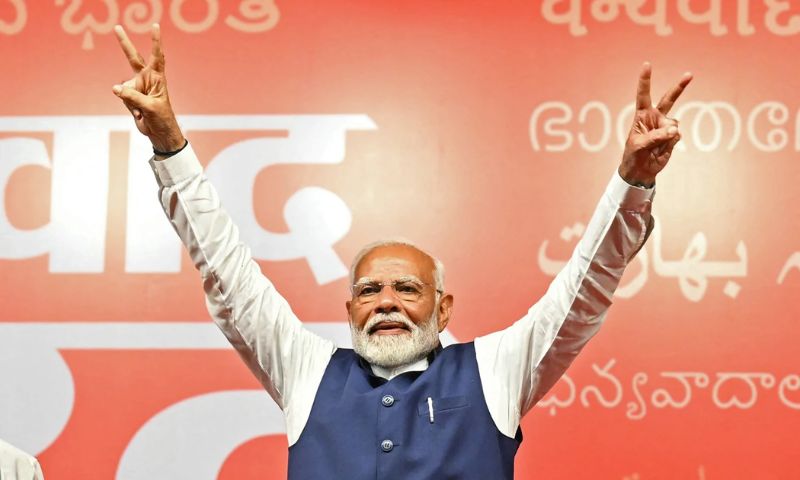NEW DELHI, India: Newly elected lawmakers of Prime Minister Narendra Modi’s National Democratic Alliance (NDA) gathered in New Delhi on Friday for their first meeting, where Modi will be formally chosen as their leader.
This step precedes his presentation of the claim to form a new coalition government. Despite Modi’s anticipated third consecutive term as prime minister, this election marks the first time his Bharatiya Janata Party (BJP) has required support from regional parties to form the government.
The BJP secured 240 seats, falling short of the 272 needed for an outright majority. The NDA as a whole won 293 seats in the 543-member lower house of parliament, while the INDIA alliance led by Rahul Gandhi’s Congress party secured over 230 seats, surpassing forecasts. Modi’s allies, including the Telugu Desam Party (TDP) and Janata Dal (United), are reportedly eyeing the post of Speaker in the lower house. The BJP is expected to retain key ministries such as foreign affairs, defence, interior, and finance.
This coalition formation echoes the pre-2014 era when alliance partners negotiated for positions and benefits before Modi’s BJP achieved an outright majority. After a meeting with party lawmakers on Friday, Modi will attend an NDA meeting for his formal election as leader. Later, he is expected to meet President Droupadi Murmu to stake his claim to form a government, with the swearing-in ceremony slated for Sunday.
Rahul Gandhi has demanded an investigation into significant stock market movements towards the election’s end, alleging that Modi provided misleading investment advice.
The recent election results have altered the perception of Indian politics. Contrary to predictions of a BJP supermajority, the party secured only 240 seats. Nevertheless, the BJP remains the largest party and will form a coalition government. Modi’s weakened mandate has impacted his political standing, with analysts suggesting that he will face challenges from both opposition leaders and internal party rivals.
Modi’s third term offers stability and predictability, reassuring investors. Malcolm Dorson of Global X highlighted the positive market impact of Modi’s leadership, emphasizing the continuity in India’s democratic system. Aastha Gudwani of Bank of America noted that while some reforms might be delayed in a coalition, the reform agenda remains intact. However, the weakened mandate might impede growth by making it harder to liberalize agricultural, land, and labor markets, potentially steering the BJP away from hardline Hindu nationalist policies.
Historically, coalitions have been profitable for investors. Data shows that under previous coalition administrations, India’s Nifty 50 index rose by an average of 109% per parliament. Analysts from Morgan Stanley predict a 12-15% annual return on the Sensex over the next five years, driven by macro stability.
Investors will closely watch Modi’s new government, particularly the budget reveal in July. The government’s stance on infrastructure investments and welfare subsidies will be pivotal. Goldman Sachs’ Pulkit Patni expects continued focus on capital expenditure, with manufacturing, railways, and defence sectors being key areas of interest.
Indian stocks have recovered from an initial 6% loss on election results day, with the Nifty 50 index up 5.16% this year. The 10-year Indian government bond yield remains steady at 7.02%. India’s central bank is expected to hold interest rates at 6.50%, while the U.S. Federal Reserve is also anticipated to maintain rates in its upcoming meeting.
This election outcome represents a shift towards a balanced government, providing a system of checks and balances that could benefit both Modi’s administration and India’s broader economic landscape.























